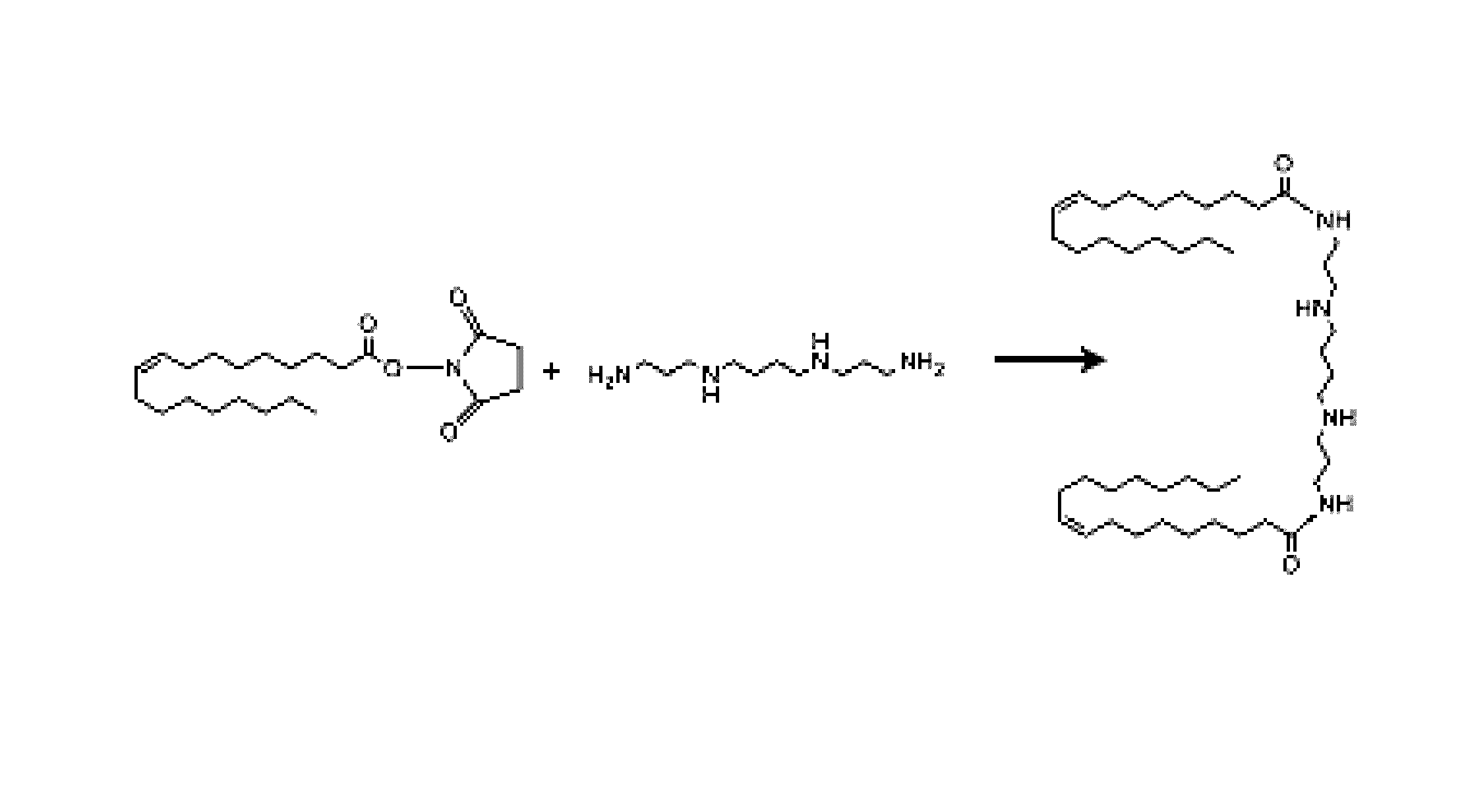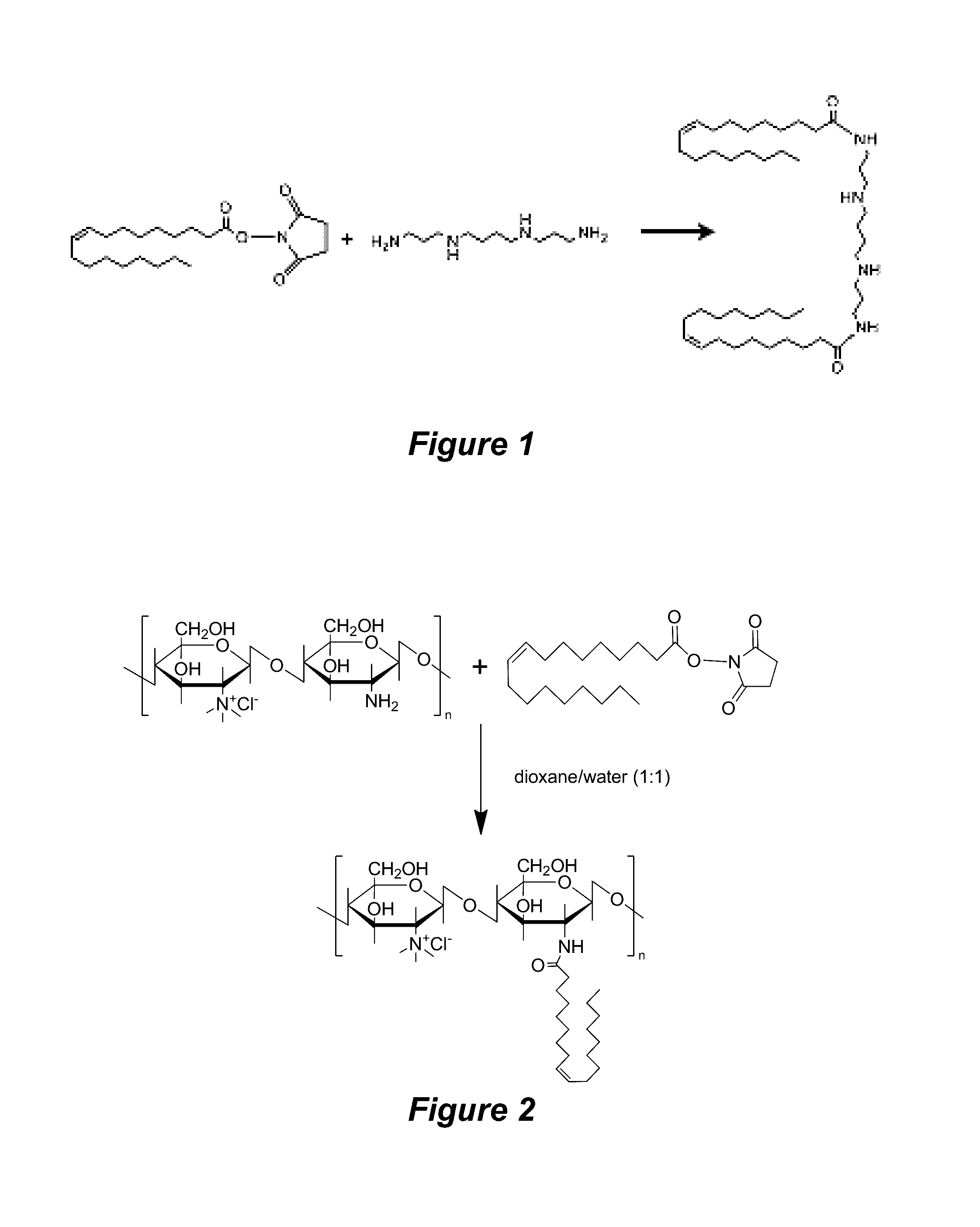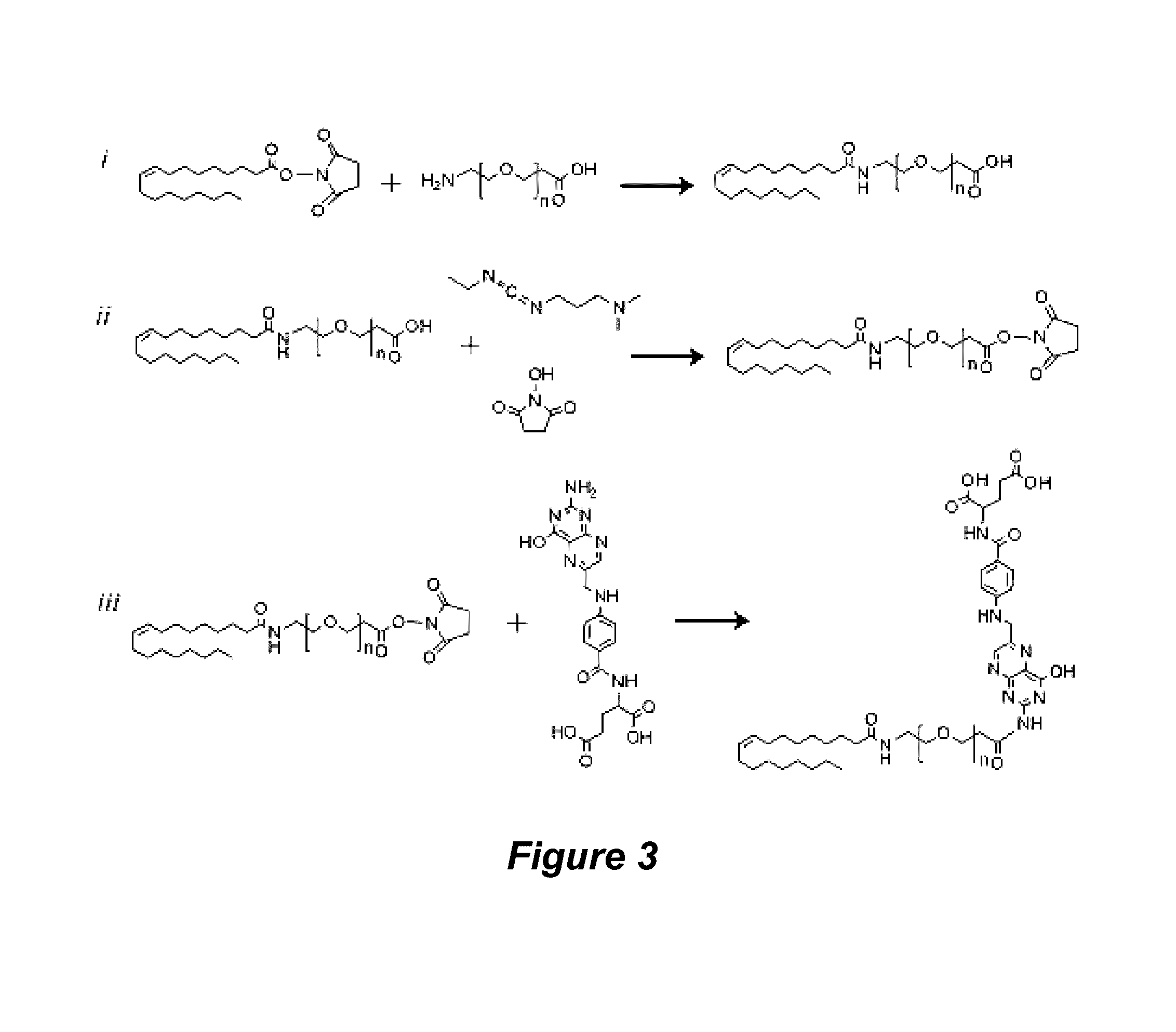Multiplexed supramolecular assemblies for non-viral delivery of genetic material
a multi-molecular, genetic material technology, applied in the direction of capsule delivery, microcapsules, gene material ingredients, etc., can solve the problems of poor gene delivery efficiency, large order of magnitude below the gene delivery efficiency of viruses, and design is, in general, too complicated or too molecule-specific to allow them to be used in conjunction with one another, and achieves remarkable in vitro transfection efficiency. , the effect of facilitating intestinal absorption of tnf- sirna
- Summary
- Abstract
- Description
- Claims
- Application Information
AI Technical Summary
Benefits of technology
Problems solved by technology
Method used
Image
Examples
example 1
Synthesis of Dioleoylspermine
[0140]NHS (11.6 mmol, 1.33 g) and DIEA (7.8 mmol, 1.35 mL) were mixed in THF (50 mL). The mixture was placed in an ice bath and cooled to 0° C. Oleoyl chloride (7.8 mmol, 3 mL) was added dropwise over the course of 1 h. The mixture was allowed to stir at 0° C. for 2 h and then overnight at room temperature (˜23° C.). The resulting precipitate was discarded by centrifugation. THF was removed under reduced pressure and the resulting yellowish oil was dissolved in methylene chloride (10 mL). The mixture was washed with 5% HCl (10 mL×2) and then evaporated under reduced pressure to give the crude product. Oleyl-NHS was crystallized from cold ethanol and characterized by 1H NMR. 1H NMR (CDCl3): δ 5.34 (m, 2H), 2.83 (s, 4H), 2.594 (t, 2H), 2.004 (m, 4H), 1.74 (m, 2H), 1.38 (m, 20H) and 0.874 (t, 3H). Spermine (0.60 mmol, 120 mg) and oleyl-NHS (1.9 mmol, 459 mg) were dissolved in a 2:1 mixture of water and THF (6 mL). The reaction was allowed to proceed overnig...
example 2
Synthesis of Oleyl-trimethyl-chitosan (OTMC)
[0141]Chitosan power (2 g) was dispersed in 80 mL NMP, into which 5.5 mL of 15% NaOH was added dropwise. Iodomethane (12 mL) was quickly added, and the reaction was allowed to proceed at 60° C. for 120 min. Three fold (v / v) of ethanol / ether (1:1, v / v) was added to precipitate the product, which was dissolved in 20 mL 5% NaCl solution for ion-exchange for three times. Anion-exchange resin was subsequently adopted to further exchange the I− to Cl− until the I− concentration was beyond detection using a starch / hydrogen peroxide reagent. The product was lyophilized to obtain trimethyl chitosan (TMC). Quarternization degree was determined by 1H NMR to be 30%.
[0142]OTMC was synthesized through amide bond formation between TMC and oleyl acid. Briefly, TMC (100 mg) and oleyl-NHS (459 mg) were dissolved in 5 mL dioxane / water (1:1, v / v), into which DMAP was added as catalyst and TEA was added to maintain the alkaline pH. The reaction was allowed to ...
example 3
Synthesis of Oleyl-PEG-COOH and Oleyl-PEG-Folate (OPF)
[0143]Oleyl-PEG-COOH was obtained by reacting NH2-PEG-COOH (3.4 kDa, 0.07 mmol, 240 mg) with oleyl-NHS (0.07 mmol, 52 mg) in a 2:1 mixture of THF and water (6 mL). The reaction was allowed to proceed overnight at room temperature, after which it was dialyzed against water using a 2,000 MWCO dialysis membrane (Spectrum Laboratories, Rancho Dominguez, Calif.). After dialyzing for two days, the product was lyophilized and characterized by MALDI mass spectrometry. Individual peak shifts (relative to unmodified NH2-PEG-COOH) corresponding to the addition of one oleyl group per PEG were observed (m / z=266).
[0144]OPF was synthesized by reacting oleyl-PEG-COOH (0.04 mmol, 140 mg) with EDC (0.04 mmol, 7.6 mg) and NHS (0.04 mmol, 4.6 mg) in DMSO (2 mL) to form oleyl-PEG-NHS. The crude product in DMSO (1 mL) was then reacted with folic acid (0.024 mmol, 10.5 mg) in 20 mM HEPES (3 mL). The reaction was allowed to stir overnight at room temper...
PUM
| Property | Measurement | Unit |
|---|---|---|
| diameter | aaaaa | aaaaa |
| diameter | aaaaa | aaaaa |
| diameter | aaaaa | aaaaa |
Abstract
Description
Claims
Application Information
 Login to View More
Login to View More - R&D
- Intellectual Property
- Life Sciences
- Materials
- Tech Scout
- Unparalleled Data Quality
- Higher Quality Content
- 60% Fewer Hallucinations
Browse by: Latest US Patents, China's latest patents, Technical Efficacy Thesaurus, Application Domain, Technology Topic, Popular Technical Reports.
© 2025 PatSnap. All rights reserved.Legal|Privacy policy|Modern Slavery Act Transparency Statement|Sitemap|About US| Contact US: help@patsnap.com



